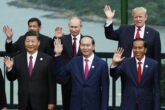October 08, 2018
Fort Trump Is a Farce
Last month, Polish President Andrzej Duda asked U.S. President Donald Trump to build a military base in Poland and even offered to pay $2 billion for it. Savvy to the workings of the U.S. president’s heart, he suggested the name Fort Trump.
A permanent U.S. military presence in Poland has been a top priority for a succession of Polish presidents. Duda saw his chance and went for it. Trump said he would look “very seriously” at the proposal, which is more than the Poles have gotten from past U.S. presidents. Does he have any idea that Fort Trump could be even harder and more expensive to build than his wall on the Mexican border?
Like Trump’s Space Force, the idea of Fort Trump is easy to mock. But also like the Space Force, the underlying issue is a serious one, and a U.S. military facility of some type in Poland has been under the microscope in the U.S. Defense Department since the Russian invasion of Ukraine in 2014. The Poles are pushing for a base that could house a U.S. armored division—that’s thousands of soldiers. Congress is interested in the issue too: The 2019 National Defense Authorization Act instructed the Pentagon to prepare a report on stationing troops in Poland.
Since the end of the Cold War, Poland has been anxious about the return of Russian domination. Given the country’s history of occupation by Russia, that’s understandable. The Poles trust the United States more than the United Nations, NATO, or the European Union to keep the Russians out. Warsaw’s insurance policy is U.S. skin in the game—if it could get a big, 1950s-style U.S. base in Poland full of troops, their dependents, and the staples of U.S. bases around the world—a Post Exchange shopping center and a baseball field—the United States would be even quicker to send in the cavalry if Poland were attacked. To some Polish strategists, it is not the military utility of a U.S. base that is important, but the American hostages the base would represent should the Russians appear on the horizon.
Washington has had to deal with this Polish paranoia since the Warsaw Pact ended in 1991. In 1999, Poland was one of the first former Warsaw Pact countries to join NATO; in fact, it was Poland that clamored the loudest to join, which was critical in pushing the organization to consider enlargement. But the Poles soon realized that NATO was focused more on the Balkans than on Russia—this was long before the invasion of Georgia in 2008—and was not quite the military giant they had originally assumed it was. So, Warsaw fastened its sights on the United States and began to search for ways to keep the Americans from wandering away.
Read the full article in Foreign Policy.
More from CNAS
-
Mike McFaul on Autocrats vs Democrats
Are we in a new Cold War? That is the question Mike McFaul takes on in his new book, Autocrats versus Democrats: Russia, China, America, and the New Global Disorder. McFaul ar...
By Andrea Kendall-Taylor & Jim Townsend
-
A New Era of Strongman Rulers Is Upon Us
The consequences of strongman rule also seep into the fabric of economies and everyday life....
By Andrea Kendall-Taylor
-
Did Europe Change Trump's Mind on Ukraine?
The Trump administration made a major move this week in its announcement of sanctions on major Russian oil companies Rosneft and Luke Oil, along with 31 subsidiaries. This fol...
By Andrea Kendall-Taylor & Jim Townsend
-
Transatlantic Security / Energy, Economics & Security
Bloomberg Tech | Day 1 | Opening Night DebateGeoffrey Gertz, senior fellow, joined Bloomberg Tech's opening night debate and attempted to answer the question “Is Europe Too Late to Compete in the Chip War?” The U.S. and ...
By Geoffrey Gertz




